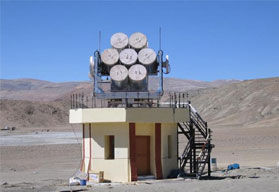Indian Astronomical Observatory, Hanle
 The gamma ray energy region in between that of the satellite experiments ( ~ 10GeV) and of the traditional Atmospheric Cerenkov experiments ( ~250 GeV) has not yet been explored. While the total number of astrophysical sources(like AGNs, pulsars etc)at ~10GeV is about 100, the number at ~250 GeV is less than 10! Thus, this is the energy region where photon generating processes seem to cease and thus interesting information is expected about these sources. There are essentially two methods for atmospheric Cerenkov experiments to reach lower energy thresholds. The first is to use very large size telescopes to collect the meager number of Cerenkov photons at these energies. The second method is to conduct experiments at very high altitudes where the number of Cerenkov photons is high enough to still allow the use of smaller telescopes. IIA, in collaboration with TIFR, has taken the second approach and has started work on a gamma ray experiment, the high energy gamma ray telescope (HAGAR) to be conducted at Hanle which will address this exciting energy range.
The gamma ray energy region in between that of the satellite experiments ( ~ 10GeV) and of the traditional Atmospheric Cerenkov experiments ( ~250 GeV) has not yet been explored. While the total number of astrophysical sources(like AGNs, pulsars etc)at ~10GeV is about 100, the number at ~250 GeV is less than 10! Thus, this is the energy region where photon generating processes seem to cease and thus interesting information is expected about these sources. There are essentially two methods for atmospheric Cerenkov experiments to reach lower energy thresholds. The first is to use very large size telescopes to collect the meager number of Cerenkov photons at these energies. The second method is to conduct experiments at very high altitudes where the number of Cerenkov photons is high enough to still allow the use of smaller telescopes. IIA, in collaboration with TIFR, has taken the second approach and has started work on a gamma ray experiment, the high energy gamma ray telescope (HAGAR) to be conducted at Hanle which will address this exciting energy range.
The Monte Carlo simulations involve the generation of Cerenkov photons at the needed altitude for gamma ray and cosmic ray primaries for various energies and for the geometry of the particular experiment . The transmission and fluctuation of photons and conversion to photoelectrons using proper reflectivity and quantum conversion parameters is a necessary intermediate step. Thus after the telescope response is obtained for all gamma ray and cosmic ray events, different conditions were imposed to generate a triggered event . Later the energy distribution of triggered events is studied to find the peak threshold energy and other parameters . These calculations for the proposed setup show that a threshold energy of ~ 50 GeV is achievable with Atmospheric Cerenkov technique at the altitude of Hanle. While a slope of 1.5 was used for the slope of the gamma ray spectrum, a lower (higher) energy threshold was obtained for a steeper (flatter) spectrum source. It was also seen that the threshold also varies with the type of trigger and the amount of chance coincidence accepted. If there are other means to identify gamma ray events, a higher chance coincidence can be tolerated which will yield lower energy thresholds. These simulations are undergoing further refinements.
HAGAR is an Atmospheric Cerenkov experiment with 7 telescopes, each with 7 mirrors of total area of 4.4 sq.mtrs - the total light gathering area of 7 telescopes is thus 31 sq.mtrs. The telescopes are deployed on the periphery of a circle of radius 50 meters with one telescope at the center. Each telescope has alt-azimuth mounting. Each of the 7 mirrors in each telescope is looked at by a UV sensitive PhotoMultiplier Tube. All seven units are installed, and calibration tests are underway.

